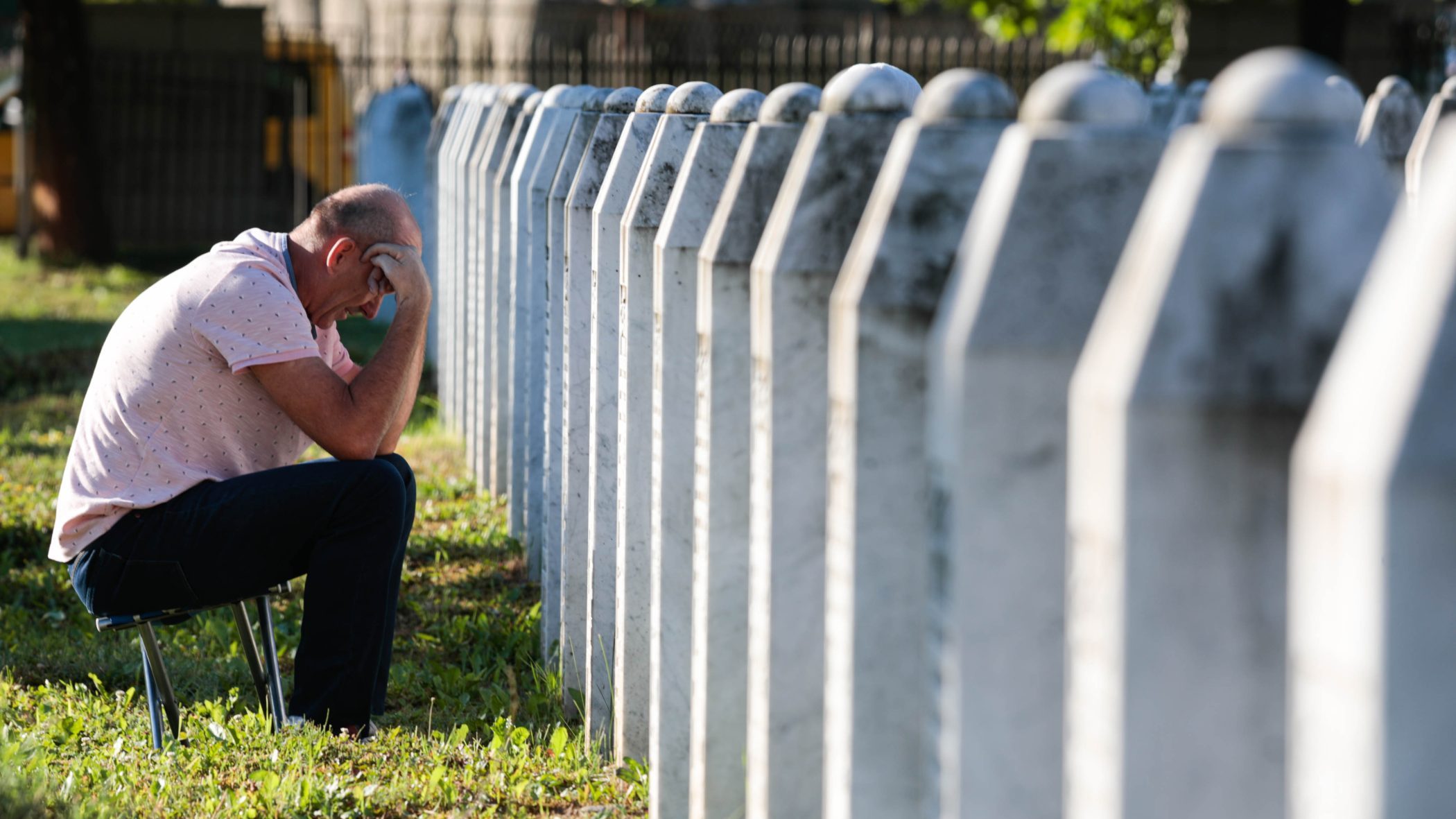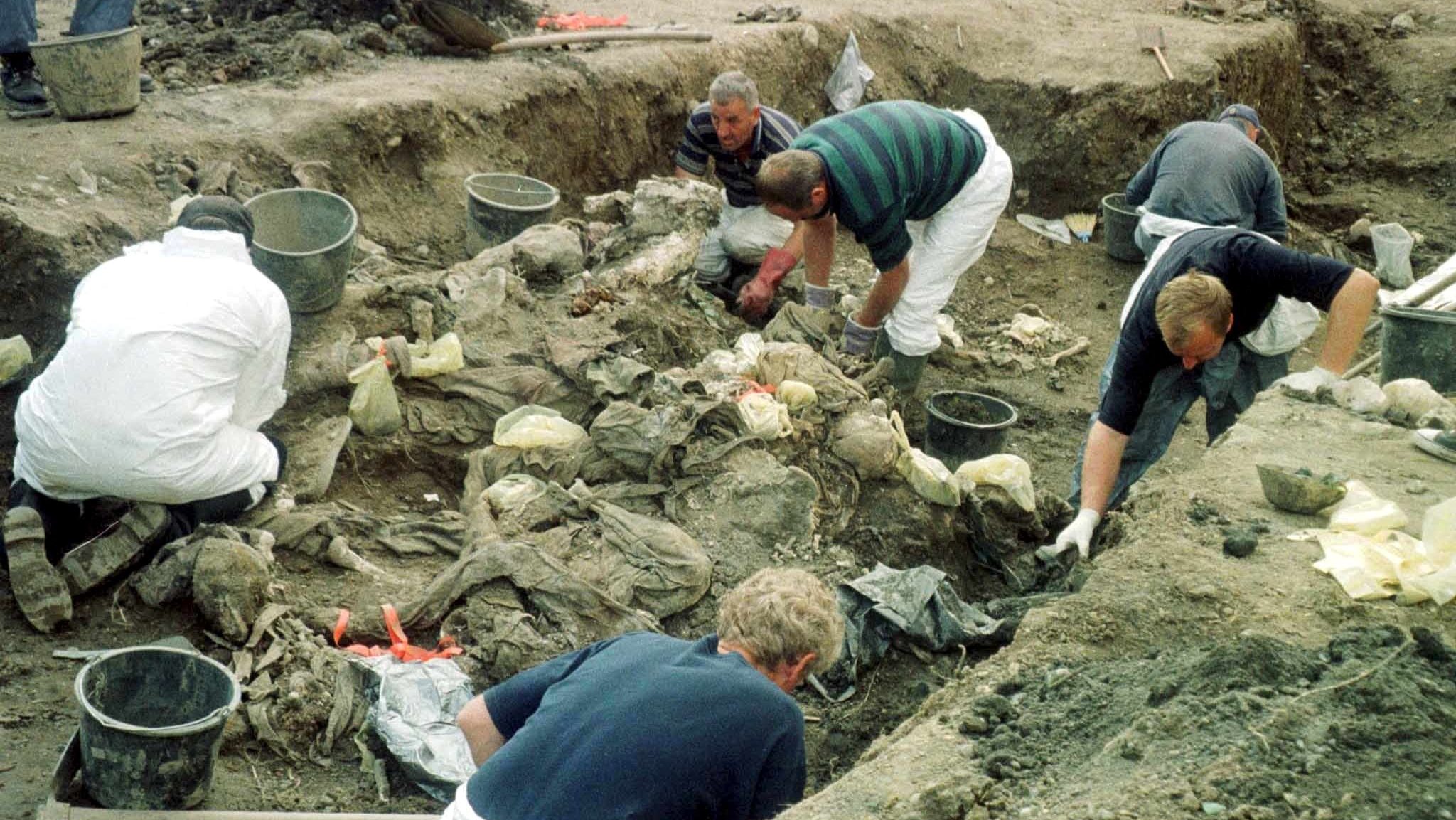This post is also available in: Bosnian
Part of his remains were found in one of several mass graves in the village of Kamenica, near Zvornik in eastern Bosnia, where many bodies of people from Srebrenica were discovered. She recognised him by his belt and sports shoes.
So far she has buried two parts of her son’s body in funeral ceremonies held 11 years apart.
“I buried him twice, in 2011 and 2022, but I have still not buried him whole. His head has still not been buried. He was killed next to the battery factory in Potocari while looking for me,” Gurdic said.
Thousands of Srebrenica residents fled to Potocari in July 1995, seeking protection inside United Nations peacekeeping troops’ compound there.
Mehrudin was among those who did not survive, and is one of 917 children, including 29 babies, who went missing during the Bosnian war. His mother also lost her husband and another son.
The remains of 373 children under the age of 18 who disappeared during the war have yet to be found. As time passes, less new information about hidden grave sites emerges, and fewer surviving witnesses remain alive.
A total of 445 children and minors who went missing during the Srebrenica genocide have been exhumed so far, according to the Bosnian Missing Persons Institute.
Munira Subasic, head of the Mothers of Srebrenica and Zepa Enclaves Association, said that several young children and teenagers have been buried in the cemetery at the Srebrenica Genocide Memorial Site, including one baby, Fatima Muhic.
“According to our records, two more babies are being searched for… One baby was killed in front of us as we were about to leave Potocari on buses . A soldier took it because it was crying and killed it,” Subasic said.
“We’ve heard that the second one was killed in Potocari after being born. We wrote about it to the Court of Bosnia and Herzegovina and Hague Tribunal,” she added.
As well as the lack of new quality information about grave locations, the Bosnian Missing Persons Institute also doesn’t have enough investigators. At present, there are 15 of them.
“That is not nearly enough for such a difficult and complex job, which continues to be performed with commitment even three decades after the war. It takes a lot of knowledge and skills to do this job, and all the circumstances are complicating the investigators’ fieldwork even more,” the Institute said.
‘We found a four-month-old baby’

Sadmir Alibegovic, the head of the Association of Detainees from Sanski Most in the country’s north-west, said that 47 people under 18 were killed in the municipality during the war, including two babies who were under a year old.
“Most of were killed by shells in their houses and yards where they were playing. In the Kamenica detention camp in Drvar, one of our women gave birth and a soldier killed the child. A detainee witnessed that. The mother and father were killed later,” said Alibegovic.
“None of the members of the family from Hrustovo have been found,” he added.
At least 15 members of another family from Hrustovo, mostly women and children, were killed in a garage on May 31, 1992. Bosnian Serb Army troops started shooting at the garage and then also at panicked civilians who were trying to get out, the Hague Tribunal stated in several of its judgments.
Amor Masovic, who was on the board of directors of the Bosnian Missing Persons Institute, has recalled how investigators found the body of a baby at the Laniste 1 mass grave site, a deep pit near the town of Kljuc.
During the exhumation the investigators saw that refuse had been dumped on top of the bodies of 77 people they found in the pit.
Masovic said that they removed the rubbish and dug down to a depth of about 18 metres below ground, where an additional 111 bodies were found. They also found a pacifier belonging to a baby who they knew had been killed alongside other members of the Dzaferagic family, including the baby’s mother and four-year-old brother, in Biljani in July 1992.
“After the discovery of the mother, brother and other family members, we began to fear that the baby’s body was simply not in that pit,” said Masovic.
“On the last day, when we were already afraid that we had maybe thrown the tiny body away with the refuse material, we discovered the remains of four-month-old Amila Dzaferagic.”
‘A mother hugged one small bone’

In the Prijedor area in north-western Bosnia during the war, 102 children were killed. According to the Izvor Association, a local human rights NGO, 32 minors are still missing in the area.
“Activities to find the children have not stopped, but the lack of information represents a problem,” said Izvor Association president Seida Karabasic.
“We’re constantly working to find children in Zecovi , where several of them were killed. It’s a bit more difficult when it comes to individual cases. They may have been exhumed already and recorded as unidentified persons, you never know,” Karabasic added.
Eighteen children were killed in an attack by the Bosnian Serb Army on the hamlet of Gradina and the village of Zecovi on July 25, 1992. The youngest victim was two and the eldest was 17.
On that day, Fikret Bacic lost his wife and two children – Nermina, who was 12, and Nermin, six – as well as other members of his extended family.
“The surviving family members are actively working and cooperating with SIPA , investigators, and the Institute. We paid for some information, we gave out some money, but it turned out that the information was false,” Bacic said.
Prijedor is situated in Bosnia’s Serb-majority Republika Srpska entity, where the Centre for the Research of War, War Crimes and the Search for the Missing also said that it’s hard to get information about missing persons from witnesses now, considering that nearly 30 years have passed since the end of the war.
It said that 31 children were on Republika Srpska’s missing persons list. Of these children, 22 bodies have been found and identified, while the remains of nine are still missing.
“The most missing children reportedly disappeared in the village of Bravnice in the Jajce municipality, in the Javorska Kosa area, and in the village of Medari in the Republic of Croatia,” the Centre said.
In the village of Grabovica in Republika Srpska, where 33 Bosnian Croats were massacred by Bosnian Army troops in September 1993, the remains of three-and-a-half-year-old Mladenka Zadro and her mother Ljubica have never been found.
Josip Dreznjak, president of Grabovica ’93 Association of Croatian Victims, said that 17 other people who were killed that day are also still missing.
Back in 1994, 11 bags of human remains were handed over in an exchange between the Croatian Defence Council, the Bosnian Croat wartime force, and the Bosnian Army.
“Only two bodies were complete. I tried to find out where those bodies had been exhumed, so we would try to find others at the same locality,” Dreznjak recalled.
But the families are still looking. “We cannot bring those people back to life, but we can help each other in finding them,” he said.
Another of the missing children in Republika Srpska disappeared during an attack by the Bosnian Serb Army on Vrbanjci and Kotor-Varos on June 25, 1992, when more than 100 people were killed.
“Safet, Fatima and their son Fikret Ramic were killed in the yard of their house in Vrbanjci. Their mortal remains have never been found,” said Semina Alekic, chair of the Coordination of Families of the Missing in Bosnia and Herzegovina.
Alekic argued that the lack of political to find the remaining missing persons is the key problem today.
“Witnesses die, witnesses are intimidated. Some have been bribed, some blackmailed, some are afraid or wait for the last moment to pass the information on to someone else,” she said.
In the Krajina region of the country, 64 minors have yet to be found. Mujo Begic, head of the Missing Persons Institute’s office in Bihac, said that the hardest thing for investigators is to meet mothers who are still searching for their children.
When mothers find even a small part of their lost child, the impact can be emotionally devastating.
“We had a case where a mother kissed, hugged and talked to one small bone,” Begic recalled.
He appealed to anyone who has information about potential mass graves to report it to the Missing Persons Institute or call the organisation’s anonymous hotline.
“Our work is not done until we find the rest of the victims,” he said. “We owe it to the families.”

